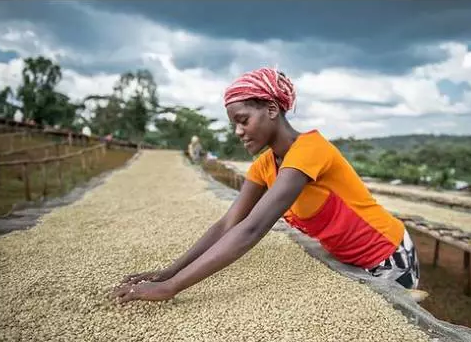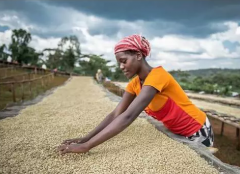Ethiopia boutique coffee producing area WenagoG1 Yadamei of Ethiopia
In addition to the small town of Yega Xuefei, it also includes three by-product areas such as Wenago, Kochere and Gelena/Abaya around it.
1. Planting system and environment the mountain stream village in the Yega Xuefei producing area is cool and foggy, like spring all the year round, with a gentle breeze in summer, cool but not hot, rain but not damp, and no cold damage in winter, which is the best environment for planting Arabica. There are no large coffee plantations. Coffee farmers mix coffee with other crops, usually under banana trees, to form a unique landscape.
2. The traditional way of solarization in Ethiopia is rough and smelly, which has been criticized by people. In 1959, the South American water washing method was introduced into the Yega Xuefei producing area. Most producing areas generally adopt the water washing treatment, that is, after the coffee fruit is peeled, the pectin layer is removed after fermentation and washing, and then dried. Since 2006, some coffee processing plants in some producing areas have adopted the exquisite elevated shed sun drying method, which invests in high-intensity human labor, which isolates the coffee fruit from contact with the ground and prevents the miscellaneous smell of soil in the process of sunlight. create an unusually clean fruit flavor. After more than two weeks of sun exposure, dark brown coffee fruits are professionally stored, waiting for the whole flavor to ripen. Before sale, the sun-dried cherry pulp and sheepskin are removed, and then the unripe beans and over-fermented beans are removed. Strict control greatly improves the quality of sun-dried beans.
3. Flavor and characteristics
Washed Yega Chuefei: it has a unique lemon flavor, refreshing jasmine flavor, as well as soft fruit acid and citrus flavor, fresh and bright taste.
Sun Yega Chuefei: with charming fruit acidity, clean fermented fruit sweet, elegant fruit wine, sweet finish.
4. The grading system of grade Ethiopian coffee is not based on the number of items, but on the proportion of defective beans in raw beans. Ethiopia launched the ECX boutique coffee trading grading system, and Q-Grader made the following grades through the evaluation of raw beans: washed Yega Xuefei is divided into Grade 1 and Grade 2, Sun Yega Xuefei is divided into Grade 1, Grade 3, Grade 4, Grade 5, and Grade 1 is the highest grade, that is, Yega Xuefei with the lowest defect rate and the best quality. This article is sorted out according to Han Huaizong's "Fine Coffee" and other contents of the Internet.
Adamay Ethiopia Yegashev G1 Adamei Ethiopia Yirgacheffe G1 Washed Adame Gorbota
Country: Ethiopia
Producing area: Varnago
Altitude: 1750m
Treatment: washing
Grade: G1
Variety: original species
Flavor description: tea, Earl black tea, longan honey sweet
The Adamei Cooperative (Adame Gorbota Cooperative) belongs to the Wenago producing area in Ethiopia, about two kilometers from the town of Yegashev in the southwest. The Yadamei Cooperative (Adame Gorbota) currently has 533 members. Small coffee farmers in the vicinity of the cooperative will collect red coffee fruits on farmland where they do not own much land, and then deliver them to the co-operative and hand it over to the cooperative for processing. The traditional YCFCU treatment process is carried out in the treatment plant. The raw coffee beans are fermented in water for 48 hours and then washed and dried on the African scaffolding. This unique treatment allows Ethiopian native species to show a strong flavor: the pleasant sweetness of apricot and the juicy feel of meticulous acidity.

Important Notice :
前街咖啡 FrontStreet Coffee has moved to new addredd:
FrontStreet Coffee Address: 315,Donghua East Road,GuangZhou
Tel:020 38364473
- Prev

Central Valley Sonora Coffee Plantation Why Sunlight and Honey
Sonora Estate is located in Costa Rica's Central Valley, at the foot of the world-famous Boaz volcano. The estate covers an area of 100 hectares, of which 55 hectares are coffee growing areas, 35 hectares are virgin forest reserves, and the remaining 10 hectares are sugar cane growing areas of the estate, with an average altitude of 1200 meters. The estate's small coffee-processing plant was built near the heart of a 150-year-old
- Next

The Ethiopian raw bean Yega Shefia Damei Cooperative belongs to the Vanaguo producing area in Ethiopia.
In addition to the small town of Yega Xuefei, it also includes three by-product areas such as Wenago, Kochere and Gelena/Abaya around it. 1. Planting system and environment the mountain stream village in the Yega Xuefei producing area is cool and foggy, like spring all the year round, with a gentle breeze in summer, cool but not hot, rain but not damp, and no cold damage in winter, which is the best environment for planting Arabica. There are no large coffee plantations, coffee.
Related
- Detailed explanation of Jadeite planting Land in Panamanian Jadeite Manor introduction to the grading system of Jadeite competitive bidding, Red bid, Green bid and Rose Summer
- Story of Coffee planting in Brenka region of Costa Rica Stonehenge Manor anaerobic heavy honey treatment of flavor mouth
- What's on the barrel of Blue Mountain Coffee beans?
- Can American coffee also pull flowers? How to use hot American style to pull out a good-looking pattern?
- Can you make a cold extract with coffee beans? What is the right proportion for cold-extracted coffee formula?
- Indonesian PWN Gold Mandrine Coffee Origin Features Flavor How to Chong? Mandolin coffee is American.
- A brief introduction to the flavor characteristics of Brazilian yellow bourbon coffee beans
- What is the effect of different water quality on the flavor of cold-extracted coffee? What kind of water is best for brewing coffee?
- Why do you think of Rose Summer whenever you mention Panamanian coffee?
- Introduction to the characteristics of authentic blue mountain coffee bean producing areas? What is the CIB Coffee Authority in Jamaica?

